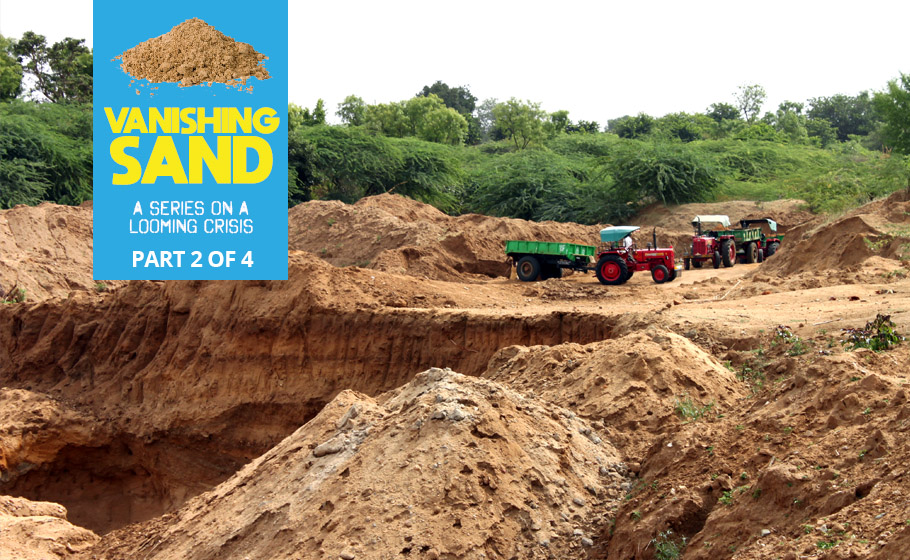
Illegal sand mining wreaks havoc in Bengaluru suburbs, coastal districts
With a ban imposed in Bengaluru city, Kolar, Chikkaballapur, Tumakuru, Mysuru, Mandya, Dharwad and Bidar, mining activity has become rampant in surrounding districts. Construction activity in prime cities lead the demand for river sand in the state.

In December 2018, 43-year-old Saheb Patel, a village accountant in Cheekalaparvi in Raichur in northern Karnataka, was run over by a tipper for trying to stop illegal sand mining activity.
Patel spotted the tipper and signalled him to stop and show the mining licence. But the driver, instead of showing him the license, ran over him. The incident sparked widespread protests in Raichur and the state police arrested the accused in less than a week.
With the ban imposed in Bengaluru city, Kolar, Chikkaballapur, Tumakuru, Mysuru, Mandya, Dharwad and Bidar, sand mining has been rampant in the surrounding districts. Construction activity in prime cities leads the demand for river sand in the state.
Patel’s murder is not a one-off incident. Whistleblowers, social activists and even officials have succumbed for checking on illegal sand mining activities. A social activist Hanumantha Bhangi, who tried to film the illegal activity in the same district in May, was attacked, with the perpetrators trying to drown him in a river.
And in March 2016, a young IAS officer DK Ravi was found dead in his house in Bengaluru. The opposition party (BJP) then stalled Karnataka Assembly several times demanding a CBI probe into the incident. Ravi, who was actively engaged in stopping illegal mining from lake beds in Kolar, whose sand was being transported to Bengaluru, had gotten into a controversy when he initiated action on Confident Group in 2011 for encroachment. During his tenure, Ravi targeted many leading builders and forced them to pay taxes.
While people suspected his alleged suicide as murder by a mafia, the CBI later ruled that his death was related to a personal cause and not because of the sand mafia.
Karnataka is one of the leading states, after Maharashtra, Madhya Pradesh and Andhra to witness rampant illegal mining.
Between 2014 and 2019, the Department of Mines and Geology registered 2,030 cases of illegal sand mining, 34,786 cases of illegal sand transportation and about 1,049 case of illegal sand storage across the state. A total of 14,786 cases have been lodged in these five years. A total of ₹77 crore fine was collected. Contractors use heavy metal objects to dig 15-25 feet trench to mine sand violating CRZ (Coastal Regulation Zone) rules in the coastal districts.
While the department officials are imposing fines and lodging complaints, the activity is rampant and they claim not enough cooperation from police officials in respective districts.
“The demand of sand in the state is about 45 million metric tonnes (mmt). Of this, about 35 MMT are met by M-sand and about 5 MMT comes from river beds and another 5 MMT from patta lands,” officials in the Mines and Geology department Deputy Director’s office said.
The state government framed a separate sand mining policy in 2016 and mandated setting up of taluk and district level committees. Besides that, the government also said any vehicle caught mining/transporting sand illegally will have to pay double the cost of the vehicle as bank guarantee to get the ceased vehicle. However, these rules have not been effectively implemented on the ground.
It also encourages manufactured sand (M-sand) production by giving incentives. While the manufactured sand (M-sand) costs about ₹900-1050 per tonne, river sand costs ₹1800-2100 per tonne.
ALSO READ: Shortage of sand spares none; world wakes up to a new crisis
Locals engage in the activity and don’t stop it as the sand mining activity fetches them an earning regularly. With failed monsoons, many farmers too have engaged in sand mining in their villages.
In the dry districts, the groundwater levels have dipped drastically. In Kolar, the groundwater level currently stands anywhere between 1,500-1,800 ft.
According to Dr SG Mayya, former professor of Department of Applied Mechanics and Hydraulics at National Institute of Technology, Surathkal, excessive sand mining affects the natural course of the river which in turn leads to river erosion and flooding during monsoon.
“Depletion of sand in the river causes ecological imbalance. It affects the natural flow of the rivers resulting in excess run-off in quick time,” says Mayya.
Mayya feels that sand mining is rampant in coastal districts as the government is ineffective in controlling the mafia. Many suggest that the government which as per the new policy grants licence of three years, should bring it down further and give licence for not more than six months.


